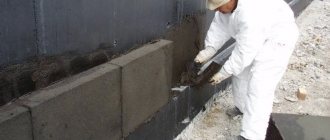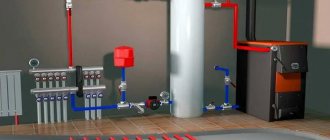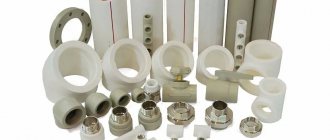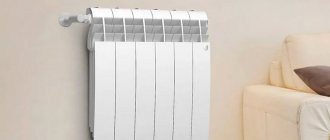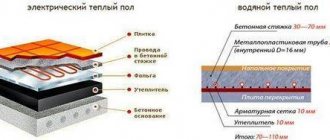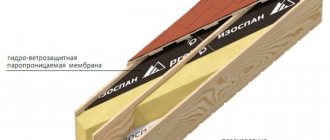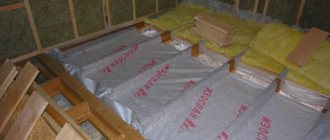The service life of building materials is determined by the influence of climatic conditions from the outside and microclimatic conditions from the inside. To maintain the latter, membranes have been developed that regulate indoor humidity. The article discusses types of vapor barriers for ceilings and popular manufacturers. Recommendations are given for choosing films for concrete and wood.
Why do you need ceiling vapor barrier?
When temperatures change, water changes its state of aggregation. The level at which this occurs is called the dew point. It occurs when heated air interacts with a cooled ceiling surface. If the latter is insulated, then condensation will collect in the insulator. If not, it will settle on building materials. Constant humidity is an environment for the development of fungus, mold and rot. The latter destroy wood and concrete, weakening their strength.
A vapor barrier for the ceiling is necessary to shift the dew point beyond the insulation, and leave condensation on the membrane. From the surface of the latter, water evaporates faster and is removed with masses of air through ventilation. Thereby:
- the service life of insulation and building materials increases;
- mold does not penetrate into the room;
- coolant consumption is reduced;
- The respiratory system is protected from insulation dust.
The vapor barrier is selected according to the material of the ceiling and insulation. A kitchen, bathroom and toilet will not be complete without it. In these rooms the evaporation rate is higher than in others.
What is the difference between the external and internal sides
Specialized vapor barrier films are made from impermeable polymer materials and cannot change physical properties depending on the side. But for ease of use, manufacturers apply markings on the outside, and some even technical markings that simplify installation. The rolls are also usually wound with the front side facing outwards and it is easier to unroll them “along the wool”, rather than from both sides.
If we consider the two-layer vapor barrier offered by some brands, then one of its sides is smooth and the other is rough.
But this does not in any way affect its ability to retain steam, just as it is not able to additionally prevent the formation of condensation. A rough surface only retains droplets of moisture on the surface, preventing them from falling and rolling off. Considering that this is a vapor barrier, and not a diffusion membrane, and condensate, subject to insulation technology, is promptly removed and dried due to ventilation, there is no particular profit from this property.
IzospanForumHouse participant
Which side of the vapor barrier, smooth or rough, by and large, makes no difference; vapor barrier does not allow either steam or water to pass through on either side. We recommend that in horizontal structures the rough side is downward - droplets of condensation do not hang on this side and, accordingly, do not drip. We recommend the diffusion membrane with the pattern facing outwards - but this is pure marketing. In fact, a vapor-PERMEABLE membrane allows steam to pass through and retains water in any direction.
Which vapor barrier is better for the ceiling?
When choosing a vapor barrier for a ceiling, the following factors are taken into account:
- type of room;
- availability of heating;
- floor material;
- budget.
If the premises are non-residential and are used as a storage room or pen for animals, then plastic film or glassine is used due to price and availability. The ceiling vapor barrier in a wooden house is constructed from polypropylene film or membrane. The fabrics effectively remove moisture from floors and insulation, protecting them. For ceilings made of concrete slabs that are insulated from the inside, a coating vapor barrier is suitable. After installation, the mineral wool is covered with a membrane. If there is no heating in the room and it is used seasonally, then a self-regulating membrane is installed. In bathhouses and steam rooms, the ceiling is protected with a vapor barrier with a layer of foil.
Advice! After installing the vapor barrier, lathing is installed on the ceiling inside the room before finishing. This is necessary for the ventilation gap between the lining or slabs and the canvas.
Types of vapor barrier films (membranes)
Vapor barrier films in the vast majority of cases are made of synthetic materials and have a complex internal structure. They differ in chemical composition, structure, specific density, thickness, mechanical strength and a number of other important parameters. The set of operational properties of any membrane is primarily related to its area of application. It is on this criterion that the classification of such products is based.
Wind and waterproof membranes
Wind and moisture protective films are capable of retaining any type of droplet moisture, including rain, snow, light drizzle or fog. At the same time, they are strong enough to withstand significant wind loads.
The structure of the wind and moisture protective membrane.
Application
They are used for external protection of fiber insulation materials installed on roofs with an angle of inclination of more than 35 degrees or vertical walls of a building. Such material prevents erosion, prevents getting wet, while at the same time allowing vapors not to reach the concentration of the beginning of condensation, but to escape freely.
Application of a wind and moisture protective membrane.
Characteristics
When choosing a wind and moisture protective membrane, first of all pay attention to the following indicators:
- Moisture resistance is measured in the height of the column of water held horizontally by the stretched material. For high-quality films it is at the level of 300-350 mm. The ability to withstand external wetting depends on it.
- Vapor permeability shows the amount of water vapor that can pass through a unit area of film per day. When covering fibrous insulation, it should be at least 3500 g/m2*day.
- Tensile strength characterizes the ability of the film to withstand extreme mechanical loads. It is directly related to the durability of the product. Due to manufacturing features, it may depend on the chosen direction, so manufacturers indicate it for longitudinal and transverse forces. Typical values range from 130 to 200 N/5cm.
- Surface density indicates the weight of one square meter of coating. It can be used when calculating the weight load and indirectly indicates the strength characteristics of the material. For thermal insulation work, films with a specific density of 100 g/m2 are used.
Designation
According to established rules, the marking of materials in this category must contain the letter “A”.
Installation rules
When placing the wind and moisture protective film, it is important not to make a mistake in choosing the sides. The rough surface, on which drops of condensate are retained with subsequent evaporation when the temperature changes, must be from the inside, i.e. should be facing the insulation, and the smooth water-repellent part should be facing outward.
The material is attached in horizontal stripes in sequence from bottom to top, overlapping with a covering of 15-20 cm, so that trickles of water cannot enter the interior space. The use of a construction stapler is not permitted. Fixation should be carried out using a counter-lattice with a maximum contact area between the bars and the film.
Vapor barrier films
Vapor barrier films are designed to stop the spread of water vapor. They protect the insulation layers attached to the roof and walls of the building from getting wet.
Vapor barrier film.
Application
Vapor barrier films are installed on the inside of the room. Without them, moisture evaporated in rooms penetrates building structures, including insulation, and condenses, reaching cold areas. This can lead to a decrease in the thermal insulation properties of insulating materials, rotting of supporting structures and the appearance of pathogenic microflora.
Application of vapor barrier film.
Characteristics
When choosing vapor barrier films, they are guided by the following characteristics:
- The vapor permeability of protective films shows the maximum amount of water vapor penetrating through them per unit time with a difference in partial pressure on both sides of 1 Pa. The smaller it is, the better the film copes with its functions. Sometimes it is convenient to use the inverse term for vapor permeability, vapor permeability resistance. For high-quality products it is at the level of 7 m2*hour*Pa/mg.
- Moisture resistance for roofing films must be at least 1000 mm water column. Even in the event of an external leak, the material will divert water to the side, preventing it from entering the interior.
- The tensile strength of vapor barrier films installed inside the roofing pie is not a critical indicator, since they do not experience wind loads. In most cases, 100-140 N/5cm is sufficient.
- For the same reason, surface density
Designation
This type of protective films is marked with the letter “B”.
Installation rules
The surface of vapor barrier films is also different from different sides. The rough layer should face towards the steam flow, and the smooth layer should face towards the insulation. In the event of an emergency depressurization of external roof elements, properly installed material will be able to protect the interior from flooding for some time.
Hydro-vapor barrier films
Hydro-vapor barrier films reliably retain moisture and vapors coming from outside, and freely allow water vapors escaping from inside the building and insulation to pass through.
Hydro-vapor barrier film.
Application
Hydro-vapor barrier films are installed on the roof to protect mineral wool insulation from getting wet.
Application of hydro-vapor barrier film.
Characteristics
The following technical parameters are typical for them:
- Water resistance at the level of vapor barrier films is not lower than 1000 mm of liquid column.
- Vapor permeability – not lower than 7 g/m2*day.
- Their tensile strength due to constant exposure to external factors is higher than that of all previous brands. It often exceeds 1000 N/5cm.
- The surface density for them is typically about 100 g/m2.
Designation
When designating this type of film, the letters are used: “C” - used for roofing pie with mineral wool insulation and “D” - used for non-insulated roofing.
Installation rules
The orientation of such films is the same. They are fixed with the smooth side up, and the rough side towards the insulation.
Material Manufacturers
To make it easier to decide which vapor barrier from which company to use, below are the pros and cons of products from manufacturers.
Klober
European company with quality control. Produces films and membranes suitable for warm and cold climates. The material is used to protect horizontal and inclined surfaces. Product advantages:
- self-adhesive tape around the edges;
- mechanical strength;
- long service life.
Disadvantages - cost and limitations on absorbent characteristics.
Juta
European manufacturer with facilities in the Czech Republic. The range consists of three-layer membranes reinforced with mesh and reinforced with a laminated coating. Two-layer fabrics from the company are based on non-woven textiles and polymer lamination. Advantages:
- mechanical strength;
- life time;
- possibility of self-installation.
Cons: decomposition of layers under the influence of ultraviolet radiation, which leads to the appearance of cracks.
Ondutis
A Russian manufacturer that supplies the market with vapor barriers with and without insulation. Environmentally friendly raw materials are used in production. Pros:
- strength;
- suitable for sloping and horizontal ceilings;
- operating temperature range from -40 to +80 °C;
- life time;
- resistance to fungus and mold.
TechnoNikol
The company's product range includes films with perforation and reinforcement, and membranes with variable permeability. Product integrity is tested on computer equipment. Advantages:
- quality;
- environmental friendliness;
- moisture resistance.
Disadvantages - high cost and complexity of installation.
Izospan
The company introduced products to the market in 2001. Consumers noted positive aspects of the vapor barrier:
- lifetime;
- environmental friendliness;
- resistance to mold and microorganisms.
Disadvantages: flammability and mechanical instability; there is no adhesive tape around the edge.
The right insulation pie
There is no need to reinvent the wheel; the vapor barrier in the house has long been thought out to the smallest detail - the correct roofing pie for a mansard-type roof is as follows:
- Interior decoration;
- A gap of 20-30 mm for air circulation (usually formed by a counter-lattice);
- Vapor barrier;
- Thermal insulation (the thickness of the insulation is the calculated value, depending on its thermal conductivity and the region of residence);
- Diffusion membrane;
- Ventilation gap 50 mm (in extreme cases, no less than 40 mm, formed by a counter-lattice);
- Lathing;
- Roofing covering.
The ventilation gaps themselves do not solve anything; air must circulate through them, keeping the structures dry. Ventilation is carried out through overhangs, covered with soffits and ridge aeration, or through dormer windows and a ridge, when installing a cold triangle.
It is impossible to lock steam in a room, set it in the desired direction and ventilate it through the vents or force it out - vapor barrier only works in tandem with ventilation of the under-roof space.
KabykiFORUMHOUSE Member
In practice, it is impossible to create an absolutely airtight structure, and this is not required - there will always be an unglued hole, cracks, and leaks. It is unrealistic to stop the phenomenon of the transition of a substance (in this case water) from one state to another (liquid, solid, gaseous). The condensation plane, also known as the dew point, is always located in the structure, from here you take a number of measures to prevent moisture accumulation - limit the flow of steam (vapor barrier) on the one hand, and ventilate the structure on the other. At the moment this is the most effective solution.
You can make a single-layer structure, you can heat it, you can install forced ventilation, but the classic vapor barrier/insulation/vent gap pie is definitely cheaper and easier to implement. I repeat - we insulate on one side and ventilate on the other. At the same time, the problem of the materials’ own moisture content is solved, which is important in our construction conditions.
When it comes to the attic floor and the cold attic, there are no fundamental differences in the insulation scheme.
- Finishing.
- Gap.
- Vapor barrier.
- Thermal insulation.
- Diffusion membrane.
- Ventilation gap.
- Sparse flooring for free movement (not always installed).
It is recommended to use a diffusion membrane over the insulation even in the case of a cold attic, as it protects against convective heat transfer, which minimizes heat loss. And in case of leakage or precipitation in the form of rain and snow, the membrane is very useful, as it will prevent the insulation from getting wet even in direct contact with water. When insulating the interfloor ceiling, both film and diffusion membrane are used. The film cuts off steam, albeit in a minimal amount, but entering the insulation through the ceiling when warm air rises upward. And the membrane will prevent particles of thermal insulation from entering the air, which inevitably occurs over time, and will protect the insulation if the floor leaks.
Insulation materials
What is the best way to insulate a cold ceiling? The main thermal insulation materials used for insulating ceilings can be divided into the following categories:
- Solid. Such materials consist of foamed plastics, are little susceptible to moisture, and are easy to install.
- Fibrous. Mats or rolls are formed from compressed fibers. Inexpensive, have good thermal insulation. Sensitive to moisture, when wet they lose their thermal insulation properties.
- Bulk. Traditional bulk materials - sawdust, expanded clay, etc. The cheapest ones have the weakest thermal insulation. Ecowool stands out separately - an expensive, but extremely effective material.
- Sprayable. Modern coatings made of foamed plastics. They are sprayed locally and do not form joints or seams. The best thermal insulation, very expensive equipment.
How to insulate the ceiling, everyone decides for themselves, based on their needs and capabilities.
Mineral wool
Rolled mineral wool The most popular type of fibrous materials. Produced from several types of raw materials:
- Basalt wool from volcanic rocks. High strength and density, short hard fibers. High moisture resistance.
- Glass wool from recycled glass. Low strength, light and elastic, long elastic fibers.
- Slag from blast furnace waste. Low thermal insulation properties, low cost. Not applicable for residential buildings.
To insulate with mineral wool, no special equipment is required; the installation process is simple and quite fast. It is produced both in rolls and in slabs with insulation thickness up to 150 mm.
Mineral wool is harmful to health; during installation you must use a respirator, protective gloves and goggles.
An important feature of mineral wool that must be taken into account when designing and installing is the large number of joints and junctions. They need to be done so that the gap is minimal, the slabs are laid against the guides and apart from each other
Half-centimeter gaps between slabs can reduce the effectiveness of the coating by a third.
Correct and incorrect installation of insulation
The thermal insulation properties of mineral wool are reduced until they are lost when the material gets wet. Therefore, it is necessary to ensure the removal of vapors and condensate.
Monolithic
The most suitable and popular material for thermal insulation of ceilings is polystyrene foam. It is produced in the form of 1200*600mm panels equipped with tongue and groove. This allows you to make high-quality joints during installation. In addition, cracks and gaps are sealed with polyurethane foam. The material is resistant to moisture and temperature fluctuations. Works great when insulating ceilings both outside and inside
We suggest you familiarize yourself with: Table of copper wire cross-section by power
Its disadvantage is low fire resistance. When burned, it releases substances harmful to health.
Insulation with polyurethane foam
Steam or hydro?
Vapor barrier and waterproofing are two groups of different films. Each group has its own varieties, which today are marked with letter designations.
- Waterproofing is films and membranes that are installed outside the thermal insulation, that is, outside the room. They protect the insulation from external moisture, that is, from precipitation. They are usually vapor permeable, so they also remove condensation from the insulation.
- Vapor barriers are films and membranes that are installed on the inside of the room, as if before thermal insulation. They protect the insulation from the penetration of water vapor from inside the house.
Now let’s figure out which side to lay the hydro- and vapor barrier.


